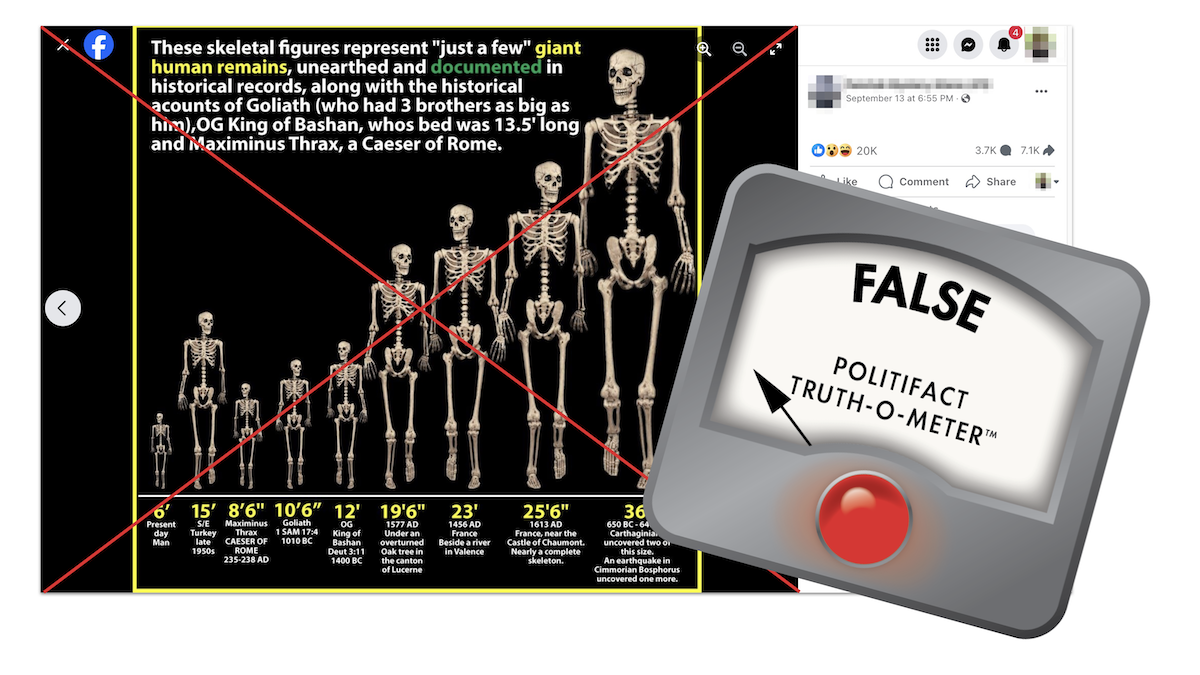

Our only agenda is to publish the truth so you can be an informed participant in democracy.
We need your help.


Giant skeleton hoaxes have been circulating online for years. Many can be traced back to edited contest pictures.
PolitiFact found no evidence to support claims that giant human skeletons have been discovered and documented.
In 2012, researchers found that a skeleton dating back to the third century had a rare growth condition called pituitary gigantism. They estimated that person would have been about 6.5 feet tall.
With October just around the corner, photos of skeletons on your social media feed may not be surprising. But beware: Some posts are just reviving false claims about giants instead of celebrating the spooky season.
"These skeletal figures represent ‘just a few’ giant human remains, unearthed and documented in historical records along with historical accounts of Goliath (who had 3 brothers as big as him), OG King of Bashan, whos bed was 13.5’ long and Maximinus Thrax, a Caesar of Rome," read the text on an image shared Sept. 13.
Beneath the words, nine skeletons of various sizes were depicted. The first and smallest, on the far left, allegedly represented a 6-foot-tall "present day man." The other eight represented people of varying sizes, some linked to specific historical figures or time periods.
This post was flagged as part of Meta’s efforts to combat false news and misinformation on its News Feed. (Read more about our partnership with Meta, which owns Facebook and Instagram.)

(Screenshot from Facebook.)
It might be fun to think about, but these claims have skeletons in their closet.
For years, unsubstantiated claims about giant skeletons have circulated online. PolitiFact and other news organizations have repeatedly debunked claims that oversized human remains were found everywhere from Ohio and New York to India and Saudi Arabia.
In many instances, the false claims were connected to edited images, such as one Reuters linked to a Photoshop contest entry that appeared to show researchers excavating an unusually large human skeleton.
PolitiFact looked into two of the post’s named "giant" skeletons, starting with Goliath, a Philistine "giant" best known for battling David in the Bible.
In 2016, archaeologists discovered a 3,000-year-old Philistine cemetery in southern Israel, which prompted this CNN headline, "Is this Goliath’s burial site? First-ever Philistine cemetery discovered." CNN reported that researchers were learning more about the Philistines from the burial grounds and that they had found some skeletons and cremated remains. It did not say that Goliath’s skeleton — or giant remains of any kind — had been found.
A researcher in 2019 suggested that Philistine "giants" such as Goliath might have earned such descriptors because of the impressively large structures the Philistines built. "All Philistine skeletal remains discovered so far have shown absolutely no evidence that the people were larger or different from normal-sized people," Bar-Ilan University professor Aren Maeir told The Times of Israel.
Also named in the Facebook post was Maximinus Thrax, who has historically been described as extraordinarily tall.
We found no evidence that Thrax’s skeleton was discovered or documented, but he was mentioned in a 2012 archeological research article: "The presence of (gigantism) in the Roman world during the Imperial Age is unknown, but the Emperor Maximinus the Thrax (235-238 A.D.) was described by literary sources as a ‘human mountain,’ and therefore he may well have been affected by gigantism or acromegaly."
In the article, researchers concluded that an unusually tall skeleton uncovered during an archaeological excavation near Rome had been "affected by pituitary gigantism, a rare growth disease." By the researchers’ estimates, that skeleton belonged to a young man who would have stood at more than 6 and a half feet tall. At the time, the average man was about 5.5 feet, National Geographic reported. The researchers did not say that the skeleton they found with pituitary gigantism was Thrax.
A Facebook post said giant human skeletons as large as 36 feet have been "unearthed and documented" in historical records.
We’ve got a bone to pick with this claim: It’s unsubstantiated. PolitiFact found no corroborating evidence suggesting these giant skeletons had been found, and the claim appears linked to previous ones about giant skeletons that have repeatedly been debunked.
We rate this claim False.
RELATED: No bones about it. Persistent rumors that giant remains were found in Ohio are still False
PolitiFact, No bones about it. Persistent rumors that giant remains were found in Ohio are still False, Sept. 20, 2022
National Geographic, ‘Skeleton of giant’ is internet photo hoax, Dec. 14, 2007
Reuters, Fact check: Images of alleged giant human skeletons are altered, March 3, 2021
USA Today, Fact check: Online post showing giant human skeletons is an old hoax, Sept. 8, 2020
National Geographic, Ancient Roman Giant Found—Oldest Complete Skeleton With Gigantism, Nov. 10, 2012
The Journal of Clinical Endocrinology & Metabolism, Pituitary Disease from the Past: A Rare Case of Gigantism in Skeletal Remains from the Roman Imperial Age, Dec . 1, 2012
Smithsonian Magazine, The Cardiff Giant was just a big hoax, Oct. 16, 2017
Factly, A Photoshopped image is being shared as ‘Goliath’s skull exhumed at Mount Elah,’ Nov. 29, 2019
Logically Facts, False: Archaeologists have found the remains of the biblical giant Goliath, Feb. 20, 2023
CNN, Is this Goliath’s burial site? First-ever Philistine cemetery discovered, July 12, 2016
The Times of Israel, Colossal ancient structures found at Gath may explain origin of story of Goliath, July 26, 2019
In a world of wild talk and fake news, help us stand up for the facts.